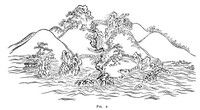HILL GARDENS. The Hill Garden (Tsukiyama-niwa) style of design is taken as the model for the most complete gardens, such as those suited to large areas in front of important buildings. An ideal Japanese landscape must contain mountain and water scenery in combination, and the term Sansui�used to denote such natural views�is also applied to the best class of artificial landscapes. The favourite classical model for these compositions is derived from the scenery of the Lake Seiko* in China, having high surrounding hills and cliffs, with a cascade leaping from the rocks in several falls (see Fig. 2, page 14). There are five different styles, any of which may be attributed to Hill Gardens:� Firstly,�the "Rocky Ocean Style," in which the stones selected should be sea rocks, the banks of the lake for the most part high and rugged, with steep cliffs for the cascade, and portions of the shore spread with white sand and planted with crooked pine trees, looking as if bent by the sea wind. Secondly,�the "Wide River Style," in which river boulders are employed and the waterfall kept low; the source may sometimes be a real or suggested stream issuing from behind a hill. The lake should resemble in form the spreading bed of a broad river, its sides being strewn with pebbles or sand. A broad sand-bank, on which water plants are grown, occupies the centre of the lake. Thirdly,�the "Mountain Torrent Style," in which a wild mountain torrent and a small lake or pool are indicated. A number of river boulders aud stepping stones are arranged in the stream, which is specially designed to suggest both swiftness and shallowness. Fourthly,�the "Lake Wave Scene," representing the wide inlet of a river expending into a lake, with no islands and very few stones, but having numerous water plants and grasses on the banks. Connected with the principal sheet of water in this design is a narrow tributary stream. A garden of this sort has no actual waterfall, but a source of water supply merely indicated and mysteriously hidden by hills or trees. Fifthly,�the "Reed-marsh Scene," in which style all hills are low and rounded like dunes, and only flat stones employed. On one side of the water extends a heath or moor covered with reeds, rushes, and bamboos, and having river plants and grasses near the banks. Close to the waterside may be planted plum and willow trees. Other special designs are mentioned, such as: � the "Style of Nine Hills and Eight Rivers," which should have four cascades in different parts of the lake; and the "Style of the Three Islands," in reference to the three Elysian Islands, called Horai, Hojo, and Eishu.
[*Conder referrs to the famous West Lake in Hangzhou, called Seiko in Japanese]

